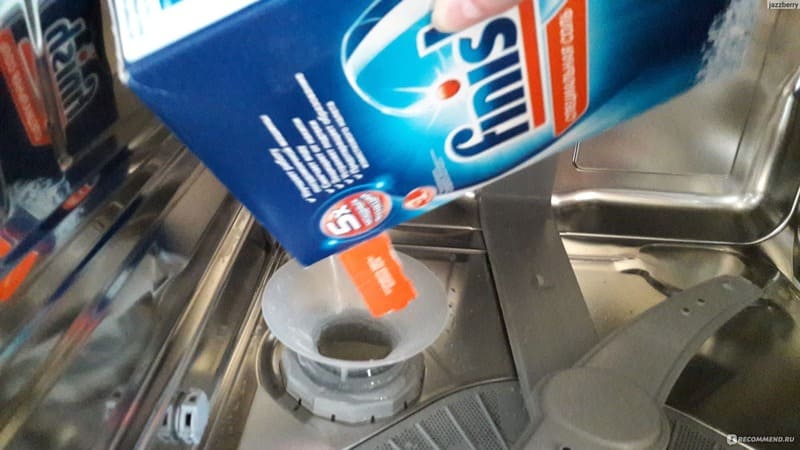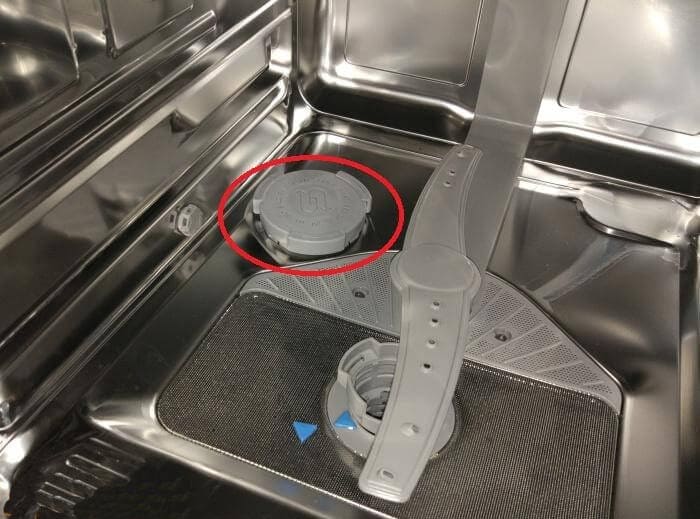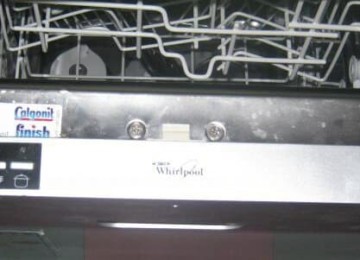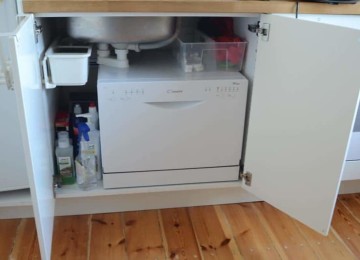For efficient and long-lasting operation, any dishwasher needs salt to soften the water. Recommendations for how much salt to put in a dishwasher are unified and practically do not differ by model and brand.
What is salt used for in the dishwasher?
In tap water, well or artesian water, salts of various metals are dissolved in any water, most often and most of all magnesium and calcium. The number of ions is an indicator of water hardness, which directly affects the quality of washing dishes, because dishwasher detergents do not work well in hard water. It is necessary to either increase the flow rate or reduce the water hardness.
But this is not all the problems. When the heating element raises the temperature of the water, a chemical reaction occurs and calcium-magnesium salts precipitate. Sediment (scale) first of all settles on the heating element of the dishwasher. It gradually, layer by layer, becomes covered with a hard shell of salts, which significantly impairs heat transfer and can lead to overheating and burnout of the heating element. In addition, a heating element coated with scale also increases electricity consumption.
Scale provokes the development of corrosion, which affects the internal surfaces of the dishwasher hopper, seams and joints, and when it finds a weak spot, it gradually corrodes and the unit fails. But rubber and plastic parts are the first to dry out from scale, and the dishwasher gradually begins to leak.
But if you don’t forget about special salt, the dishwasher will last much longer without breakdowns and will wash dishes better.
What is included in dishwasher salt?
The solution to problems with water hardness is built into the design of the dishwasher itself. It has a special compartment that contains a synthetic resin that binds metal ions from hard water using chlorine ions. The water entering the dishwasher passes through this compartment, called an ion exchanger, and is cleaned of impurities that are harmful to the machine.
Thus, the water becomes soft, and the resin needs to be “recharged” with chlorine ions. And in order for the resin to continue to work, it periodically needs to be restored (that is, regenerated), and for this you need sodium chloride (NaCl). That's why dishwasher salt is called regenerating salt.
Sodium chloride is the main ingredient in all types of dishwasher salts; it contains about 98%. The rest is at the manufacturer’s discretion: flavors, anti-caking agents, disinfectants (sodium citrate), catalysts for reducing processes (polyaspaginate) and other substances. Many of them are used only to create salts with a “brand name” (for example, salt with the aroma of lavender), and have no other meaning than aesthetics.
In addition, there is also eco-salt, which does not contain additives, except, in fact, sodium chloride itself in large crystals.
Despite the identical formulas, dishwasher manufacturers do not recommend using kitchen salt, even highly purified, boiled salt: it dissolves too quickly and still contains additives that will sooner or later lead to damage to the dishwasher.
Which salt should you choose?
Salt suitable for ionic purification must be pure, produced using the most modern evaporation and digestion technologies. There are many brands of dishwasher salts on the market, and you can choose based on your personal trust in the manufacturer, or based on the availability, prices and format of the salt itself.
With experience, it will become clear which specific salt has the largest crystals - this will be the most profitable purchase, since it will take the longest to dissolve.
Salts are produced by household appliance brands themselves, salt companies, and well-known brands of household chemicals. Manufacturers of dishwashers do not hesitate to advertise their products directly when selling units and also recommend only their product in the instructions for the equipment. Salt companies assure that consumers can also use their boiled purified salt (sodium chloride more than 99%), especially since there are now a sufficient number of varieties of coarse crystalline salt.
Salt is produced both in the usual crystalline form in boxes and bags (the leaders are Finish, Calgonit and Somat), and in bulk tablets (Tortilla, Topperr, Frau Schmidt and others), which eliminate the need to replenish the salt compartment for the time specified in the instructions. As a rule, instructions for using salt are printed in detail on the packaging.
Which salt to choose is an individual consumer decision.There is no big difference between them, there is no point in chasing after any one brand, they are all interchangeable. It is only important that the manufacturer has a good reputation and that its products have the required degree of purification. Therefore, it is advisable to buy salt in stores and in branded packaging.
The influence of water hardness on salt consumption
The harder the water, the more often you will have to add salt to the dishwasher; this is a simple mathematical calculation: more calcium ions need to be bound, which means more chlorine ions will need to be restored. You can accurately determine the hardness of water either in the laboratory or using special test strips. You can buy them in hardware departments and some pet stores, but they only give an approximate result.
Some people know how to determine water hardness by eye using indirect signs. So, water is hard if:
- laundry soap lathers poorly and does not produce foam at all;
- hair, especially long women’s hair, is poorly washed;
- scale forms in teapots quickly (within a week or two);
- a white coating forms on hot water taps quickly, that is, within a week;
- After some time, dry white, “chalky” deposits form on the shower walls and bathroom tiles;
- If you leave tap water in a cup for a couple of days, then based on the level of its evaporation, some roughness will form on the walls.
However, this method is not very informative, but you can find out the exact indicators for water from the water supply from utility companies or from regional authorities, who should have a special map of water hardness by region of the country freely available. To generalize, the further south you go, the harder the water, which means more regenerating salt will be required.
But it's not all that scary.According to consumer reviews, the average salt consumption for dishwashers is about a kilogram for two months with daily use of the unit and varies by plus or minus 300 grams, depending on the hardness of the water.
How to determine when it's time to add salt to your dishwasher
Dishwashers come with or without a special indicator that warns the user about the need to add salt. While it is burning, there is no need to add salt, or vice versa. It depends on the dishwasher, its brand, model, and year of manufacture.
The older the dishwasher, the more likely it is that the indicator will not appear. You can determine when it’s time to add salt only by constantly monitoring the operation of the equipment. If the quality of washing becomes worse day by day (the glassware after washing is cloudy, with stains, drops and is not completely washed), then it’s time to add salt. It’s better to roughly remember the cycle and fall asleep in advance, without scoffing at the technology and without waiting for catastrophic consequences. Some people solve this dilemma for themselves by adding half a pack of salt on the 10th of every month.
However, you need to take into account the time of year, because water hardness varies by season; in the fall, all samples show an increase in hardness and salt saturation in the country’s reservoirs and wells.
How much salt should you put in the dishwasher?
Manufacturers of dishwashing equipment insist that the salt container must be filled completely. On some models, when the load is sufficient, a colored bar pops up - a load indicator. On average, about a kilogram of salt is placed in a container, but according to models the figure varies from 700 to 1300 grams.
However, it is not so important how much salt is poured into the compartment at a time; it is important that there is always salt in the system.This is why models with a salt indicator on the panel are so convenient.
Some consumers believe that you don't need to add more than a kilogram, even if the salt compartment can hold more. There is a risk that excess salt will soak into the stone and only worsen the operation of the dishwasher. This opinion is rather superstitious, because large salt cannot stick together simply due to its physical properties. Although, they say, table salt clogs the machine in this way, but it is much smaller.
Where to add salt? 
Any dishwasher has a special compartment for regenerating salt, which is located next to the functional part of the water purification and softening mechanism.
Most modern dishwashers (except Miele, dishwashers of this brand have a hatch for salt in the door) have a salt container at the very bottom, at the bottom of the bunker, under the lower shelf for dishes. If you look, you can see a round ribbed screw cap. Most often, it is located on the side of the coarse filter, under the lower sprinkler.
Under the lid is a water softener, it also has a compartment for salt. Next to it is a compartment with ion exchange resin, as a rule, it cannot be opened and looked at. Next to the softener is a water softening adjustment regulator, most modern dishwasher models have seven positions: from super soft to super hard. In older versions, there may be only three positions.
But, by and large, water can be divided into three types by hardness: soft, medium hard and hard. If it is not yet clear what kind of water will go into the dishwasher, it makes sense to set the average value.If the quality of dishwashing is not very good, the regulator can be moved in the right direction.
How to properly put salt in the dishwasher?
You need to pour salt into the dishwasher immediately before the start of the cycle: the salt solution often splashes out of the container, and it needs to be washed off quickly so that the corrosion process does not start. You need to add salt carefully, it is advisable to wear gloves. The dishwasher must be empty.
After purchase, before the first start, the machine must be properly loaded with salt:
- unscrew the container lid counterclockwise;
- pour 500-1000 milliliters of water into the tank (do this only the very first time!);
- pour regenerating salt into the compartment, water will be displaced at this time;
- screw on the lid, wipe the bottom, remove any spilled salt crystals.
Please note that the lid must sit smoothly, without distortion!
By the way, dishwashers are standardly equipped with a special funnel to facilitate the process of adding salt.
Tips for using dishwasher salt
A dishwasher cannot fully function without regenerating salt, so you will have to learn how to store and use it correctly:
- Dishwasher salt should only be used for the dishwasher; other appliances have their own modifications;
- Only salt can be poured into the salt container;
- salt can only be poured into a special compartment;
- universal tablets or capsules for washing dishes do not eliminate the need to use salt;
- Children and pets should not have access to salt, as they may swallow it;
- open packaging should be stored away from moisture and sunlight;
- salt can cause an allergic reaction and severe irritation.
Any dishwashing equipment will live a long life and will delight its owners with spotlessly clean dishes if it is properly cared for. However, even the best detergents, high-quality and certified, are not enough. Caring for the inside of the machine is also important, and this requires regenerating salt, which must be regularly added to the dishwasher's designated container.









